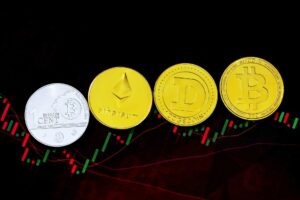In the dynamic realm of cryptocurrency, understanding the concept of halving is essential for investors seeking to navigate the market effectively. Halving events, often shrouded in intrigue and speculation, have a profound impact on the supply and demand dynamics of cryptocurrencies, ultimately influencing their prices.
This article aims to demystify the concept of halving and explore its significance in the crypto ecosystem. By delving into the intricacies of halving events and their effects on cryptocurrency prices, you can gain valuable insights to inform your trading strategies and investment decisions.
What is Halving?

Halving, also known as “halvening,” refers to a programmed event embedded within the code of certain cryptocurrencies, notably Bitcoin and Litecoin, that reduces the reward received by miners for validating transactions and securing the network.
- Compatible with major cable internet providers including Xfinity, Spectrum, Cox and more. NOT compatible...
- [Compatibility] 12V Power Supply Adapter Compatible with Netgear, Linksys, Asus,Motorola, Motorola/Arris...
This reduction occurs approximately every four years or after a certain number of blocks have been mined, leading to a halving of the block reward. In the case of Bitcoin, the initial block reward of 50 bitcoins was halved to 25 in 2012, then to 12.5 in 2016, and most recently to 6.25 bitcoins in 2020. This process continues until the maximum supply of coins is reached, after which no more halving events occur.
The occurrence of halving events is often met with anticipation and speculation within the cryptocurrency community, as they have historically been associated with significant price movements and market volatility. Understanding the mechanics of halving events is crucial for investors, as they can have a profound impact on the supply-demand dynamics of cryptocurrencies and influence their long-term value proposition.
The Impact of Halving on Supply and Demand
Halving events have a dual impact on the supply and demand dynamics of cryptocurrencies, which in turn influences their prices. On the supply side, halving leads to a reduction in the rate at which new coins are minted and introduced into circulation.
With fewer coins being generated per block, the overall supply of the cryptocurrency grows at a slower pace, ultimately diminishing the rate of inflation. This reduction in the inflation rate enhances the scarcity of the cryptocurrency, as the remaining supply becomes increasingly finite over time.
Conversely, on the demand side, halving events often trigger heightened interest and speculative activity among investors and traders. The anticipation of reduced future supply tends to create a sense of scarcity and urgency, prompting investors to accumulate coins in anticipation of price appreciation. This increased demand, coupled with the reduced supply, can create a supply-demand imbalance that drives prices upward, leading to bull markets and significant price rallies in the aftermath of halving events.
Factors Influencing the Impact of Halving Events
While halving events have historically been associated with bullish price trends, several factors can influence the magnitude and duration of their impact on cryptocurrency prices. Market sentiment, macroeconomic conditions, regulatory developments, and technological advancements all play a role in shaping investor perceptions and market dynamics before and after halving events.
Additionally, the degree of anticipation and speculation leading up to a halving event can vary, depending on factors such as media coverage, investor awareness, and the overall maturity of the cryptocurrency market. In some cases, the effects of halving events may be amplified by external catalysts or mitigated by unforeseen events, leading to unpredictable price outcomes.
Furthermore, the long-term sustainability and adoption of a cryptocurrency also play a crucial role in determining its price trajectory post-halving. While supply reduction can create short-term price appreciation, the underlying utility, adoption, and network effects of the cryptocurrency ultimately dictate its long-term value proposition and price stability.
Understanding these factors and their interplay with halving events is essential for investors seeking to navigate the cryptocurrency market effectively and capitalize on potential price opportunities surrounding these events. By considering both the fundamental and macroeconomic factors at play, you can make more informed decisions and manage your exposure accordingly.
Potential Risks and Challenges Associated with Halving
While halving events often generate excitement and optimism among cryptocurrency investors, they also carry certain risks and challenges that warrant consideration. One notable risk is the potential for overhyped expectations leading up to the event, followed by a post-halving price correction or market downturn.
In some cases, the market may have already priced in the anticipated supply reduction, leading to a “buy the rumor, sell the news” scenario where prices decline after the halving occurs.
Additionally, the increased speculative activity surrounding halving events can create volatility and market manipulation, as traders attempt to capitalize on short-term price movements. This heightened volatility may lead to increased trading risks and potential losses for investors who are not prepared to navigate market fluctuations.
Moreover, halving events may also exacerbate scalability and network congestion issues for certain cryptocurrencies, particularly those with limited transaction throughput or scalability solutions. Increased transaction demand following a halving event could strain network resources and lead to higher fees, slower confirmation times, and degraded user experience.
Strategies for Investors During Halving Events
For investors navigating halving events, it’s essential to adopt a strategic approach that balances risk and potential reward. One strategy is to accumulate assets gradually in the months leading up to the halving event, taking advantage of any price dips or consolidation periods to the dollar-cost average into positions. By spreading out purchases over time, investors can mitigate the risk of entering the market at a peak and benefit from potential price appreciation over the long term.
Another strategy is to maintain a diversified portfolio of cryptocurrencies, including both established assets like Bitcoin and altcoins with strong fundamentals and growth potential. Diversification can help spread risk across different assets and minimize exposure to any single cryptocurrency or market event.
Furthermore, investors should conduct thorough research and due diligence on the cryptocurrencies they are considering, paying attention to factors such as technology, adoption, community support, and regulatory compliance. By understanding the fundamentals of each asset, investors can make more informed decisions and identify opportunities with the highest likelihood of long-term success.
Lastly, investors must maintain a long-term perspective and avoid succumbing to short-term market fluctuations or speculative frenzy surrounding halving events. Investing with a focus on fundamentals and a clear investment thesis can help investors navigate market volatility and achieve their financial goals over time.
Conclusion
Halving events represent significant milestones in the evolution of cryptocurrencies, with the potential to impact prices and market dynamics in profound ways. By reducing the rate at which new coins are generated and introducing scarcity into the supply, halving events have historically been associated with bullish price trends and market rallies.
However, investors need to approach halving events with caution and foresight, considering the potential risks and challenges that may arise. By adopting a strategic investment approach, conducting thorough research, and maintaining a long-term perspective, you can navigate halving events effectively and capitalize on potential opportunities in the cryptocurrency market.
As the cryptocurrency ecosystem continues to evolve and mature, halving events will likely remain key events to monitor for investors seeking to understand market trends and position themselves for long-term success.
By staying informed, staying disciplined, and staying patient, you can navigate the ups and downs of the cryptocurrency market and build wealth over time.





